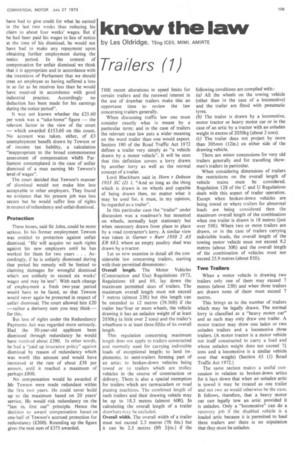know the law
Page 107

If you've noticed an error in this article please click here to report it so we can fix it.
by Les Oldridge, TEng (CEO, MIMI, AMIRTE
Trailers (1)
THE recent alterations in speed limits for certain trailers and the renewed interest in the use of drawbar trailers make this an opportune time to review the law concerning trailers generally.
When discussing traffic law one must consider exactly what is meant by a particular term; and in the case of trailers the relevant case law puts a wider meaning on the word trailer than one would expect. Section 190 of the Road Traffic Act 1972 defines a trailer very simply as "a vehicle drawn by a motor vehicle". It will be seen that this definition covers a lorry drawn by another lorry as well as the normal concept of a trailer.
Lord Blackburn said in Horn v Dobson 1933 SC (.1) I, "And so long as the thing which is drawn is on wheels and capable of being drawn then, no matter what it may be used for, it must, in my opinion, be regarded as a trailer".
In this particular case the "trailer" under discussion was a roadman's hut mounted on wheels, normally kept stationary but when necessary drawn from place to place by a road contractor's lorry. A similar view was taken in Garner v Burr 1950 2 All ER 683, where an empty poultry shed was drawn by a tractor.
Let us now examine in detail all the considerable law concerning trailers, starting with their permitted dimensions:
Overall length. The Motor Vehicles (Construction and Use) Regulations 1973, Regulations 68 and 69, lay down the maximum permitted sizes of trailers. The maximum overall length must not exceed 7 metres (almost 23ft) but this length can be extended to 12 metres (39.36ft) if the trailer has 'four or more wheels, the vehicle drawing it has an unladen weight of at least 2030kg (a little over 2 tons) and the trailer's wheelbase is at least three-fifths of its overall length.
This regulation concerning maximum length does not apply to trailers constructed and normally used for carrying indivisible loads of exceptional length; to land implements; to semi-trailers forming part of an attic; to broken-down vehicles being towed or to trailers which are trolley vehicles in the course of construction or delivery. There is also a special exemption for trailers which are tarmacadam or road planing machines. The combined length of such trailers and their drawing vehicle may be up to 18.3 metres (almost 60ft). In calculating the overall length of a trailer drawbars may be excluded.
Overall width. The overall width of a trailer must not exceed 2.3 metres (7ft 6in.) but it can be 2.5 metres (8ft 2i-in.) if the
following conditions are complied with: (a) All the wheels on the towing vehicle (other than in the case of a locomotive) and the trailer are fitted with pneumatic tyres.
(b) The trailer is drawn by a locomotive, motor tractor or heavy motor car or in the case of an attic by a tractor with an unladen weight in excess of 2030kg (about 2 tons).
(e) The trailer does not project by more than 305mm (12in.) on either side of the drawing vehicle.
There are minor concessions for very old trailers generally and for travelling showmen's trailers in particular.
When considering dimensions of trailers the restrictions on the overall length of vehicle trains must be considered. Regulation 128 of the C and U Regulations deals with this aspect of trailer operation. Except when broken-down vehicles are being towed or where trailers for abnormal loads are being considered then the maximum overall length of the combination when one trailer is drawn is 18 metres (just over 59ft). Where two or more trailers are drawn, or in the case of trailers carrying indivisible loads, the overall length of the towing motor vehicle must not exceed 9.2 metres (about 30ft) and the overall length of the combination of vehicles must not exceed 25.9 metres (about 85ft).
Two Trailers When a motor vehicle is drawing two trailers only one of them may exceed 7 metres (about 23ft) and when three trailers are drawn none of them must exceed 7 metres.
This brings us to the number of trailers which may be legally drawn. The normal lorry is classified as a "heavy motor car" and as such may only draw one trailer. A motor tractor may draw one laden or two unladen trailers and a locomotive three trailers. (A motor tractor is a motor vehicle not itself constructed to carry a load and whose unladen weight does not exceed 7+ tons and a locomotive is a similar vehicle over that weight) (Section 65 (1) Road Traffic Act 1972.) The same section makes a useful concession in relation to broken-down attics for it lays down that when an unladen attic is towed it may be treated as one trailer and not two as would otherwise be the case. It follows, therefore, that a heavy motor car can legally tow an attic provided it is unladen. Only a "locomotive" can do a recovery job if the disabled vehicle is a loaded attic because it is permitted to haul three trailers and there is no stipulation that they must be unladen.
























































































































































